
Home → Cataloging in NC Cardinal → Item Cataloging → Advanced Reader Copies, Donated Items, Item Tags(Notes), Digital Bookplates Notes, and Alerts
3.14. Advanced Reader Copies, Donated Items, Item Tags(Notes), Digital Bookplates Notes, and Alerts
Last Updated 10/27/2025
Advance Reader Copies
Advance/d Reader Copies (ARCs) or Advanced Reading Editions (AREs) are promotional materials sent out prior to publication. They are generally marked as such and usually marked "Do Not Sell". Libraries should not add these items to the NC Cardinal catalog. Some libraries may choose to circulate as pre-cataloged or non-cataloged "donations".
Gift, Donated, and In Memoriam Items
Library system specific information including gift or donation information should not be included in bibliographic records within NC Cardinal, which are shared by the entire consortium. Catalog the item as you would normally, following the recommended MARC templates for the item type (i.e., book, Blu-ray, etc.). NC Cardinal recommends that libraries use a book plate, plaque, or some other form of acknowledgment for gifted items OUTSIDE of the catalog.
For internal records, libraries may wish to
- Create an item statistical category. For example: donation: yes/no
- Use an Excel spreadsheet to track donations
- Create a COPY-level item note for each individual barcode
Item Notes
Item notes are free text fields that include a note title, note content, and checkbox to indicate whether a note is public. Public notes are visible in the OPAC, but not searchable.
Neither item note titles nor item note contents are controlled, and there is no administrative interface to control notes.
Notes can be added or edited from the Holdings Editor, or directly from the holdings view tab.
Adding Notes to Items
Item notes can be added to existing items or to new items as they are cataloged. To add an item note:
-
In the Holdings Editor, select Edit Item Notes. This will open a modal named Managing notes for item.

-
If you are in the holdings view tab, you can also select Actions → Add / Manage Item Notes. This will open the notes modal, and you can proceed to step 2.
-
-
Enter a title and content for your note. Select the Public? checkbox if you want the note to be visible in the OPAC.
-
Select Add New. The new note will appear below, under a heading labeled Pending Item Notes.
-
Repeat this as needed to add other notes.
-
Notes will remain pending until the item is saved in step #6.
-
-
You can edit or remove notes before saving. Text entries for note title and content can be edited directly in their respective fields, and you can also change the Public checkbox selection. To remove a note, select Remove on the right side of the note’s line.
-
Once you have added your notes and done any other notes work, select Apply Changes. The modal will close.
-
If you accessed the modal directly from the holdings view tab, this will save your changes.
-
To close without saving, select Close.
-
-
Proceed with the rest of your edits to the item, and then select either Apply All & Save or Apply All, Save & Exit to finish your edits.
Editing Item Notes
Note titles and content are free text, and can be edited.
-
In the Holdings Editor, select Edit Item Notes. This will open a modal named Managing notes for item.
-
If you are in the holdings view tab, you can also select Actions → Add / Manage Item Notes. This will open the notes modal, and you can proceed to step 2.
-
-
Make your desired edits to the note title, content, and public checkbox.
-
Once you have finished, select Apply Changes. The modal will close.
-
To close without saving, select Close.
-
-
Proceed with the rest of your edits to the item, and then select either Apply All & Save or Apply All, Save & Exit to finish your edits.
Removing Item Notes from Items
To remove an item note from a item:
-
In the Holdings Editor, select Edit Item Notes. This will open a modal named Managing notes for item.
-
Select Remove on the right side of the note for the note(s) you want to remove.
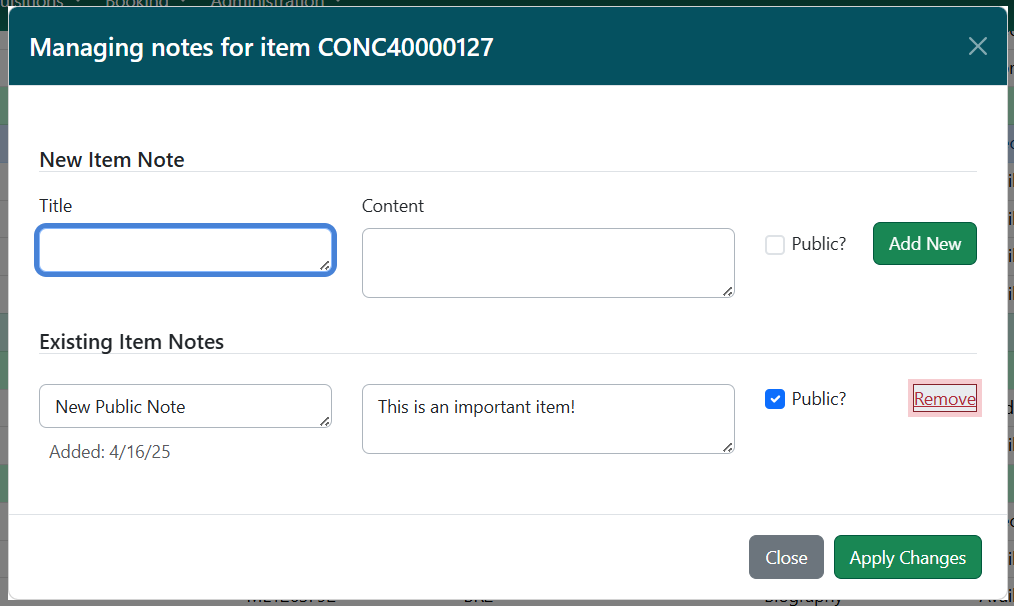
-
You can also Undelete a removed note before you close the modal. To do this, select Undelete on the right side of the appropriate note.
-
-
Once you have finished, select Apply Changes. The modal will close.
-
To close without saving, select Close.
-
-
Proceed with the rest of your edits to the item, and then select either Apply All & Save or Apply All, Save & Exit to finish your edits.
Adding Item Notes in Batch
Item notes can be added to multiple items in batch via the Holdings Editor, or directly from the Holdings View tab.
To add item notes in batch via the Holdings Editor, open a set of items in the Holdings Editor. You can do this from several entry points, including item status, item buckets, or from the bibliographic record in the Holdings View tab.
-
At whichever entry point, select your set of items and then click Actions → Edit Items.
-
If you are in the Holdings View tab, you can also select Actions → Add / Manage Item Notes. This will open the tags modal, and you can proceed to step 3.
-
-
In the Holdings Editor, select Edit Item Notes. This will open a modal named Managing notes in common for <number> item(s).
-
IMPORTANT: This modal will only show existing note labels that are commonly held among all selected items. Items do note share notes directly.

-
-
Enter a title and content for your note. Select the Public? checkbox if you want the note to be visible in the OPAC.
-
Select Add New. The new note will appear below, under a heading labeled Pending Item Notes.
-
Repeat this as needed to add other notes.
-
Notes will remain pending until the item is saved in step #7.
-
-
You can edit or remove notes before saving. Text entries for note title and content can be edited directly in their respective fields, and you can also change the Public checkbox selection. To remove a note, select Remove on the right side of the note’s line.
-
Once you have added your notes and done any other notes work, select Apply Changes. The modal will close.
-
If you accessed the modal directly from the holdings view tab, this will save your changes.
-
To close without saving, select Close.
-
-
Proceed with the rest of your edits to the items, and then select either Apply All & Save or Apply All, Save & Exit to finish your edits.
To add notes in batch using the Item Status (List View) via an item status, scan barcodes or upload a file of barcodes via the interface in the item status interface.
-
Navigate to Search → Search for Items by Barcode.
-
Scan barcodes or upload a file of barcodes in the item status interface.
-
Select the items to which you want to add the item note and go to Actions → Edit Items. The Holdings Editor will open in a new tab with all of your selected items.
-
Follow the instructions above for the Holdings Editor, starting at step 2.
|
NOTE: Copy level notes are not searchable in the OPAC. Please request a list of items with donation copy notes via help ticket. |
Item Tags and Digital Bookplates
Item Tags allow staff to apply custom, pre-defined labels or tags to items. Alternatively, a library may wish to use an Item Tag instead of an Item Note, because unlike Item Notes, Item Tags are searchable within the catalog. Some stipulations apply:
- NC Cardinal is currently limiting the "Type" of Item Tag to Digital Bookplates as these are already in use by some libraries.
- NC Cardinal asks that you create a standardized list of labels to apply uniformly to your Item Tags. For example, for all donations in memory of an individual or group, you might create the label "Donated by [insert name here] in memory of [insert name here]." You would then use that same template for all subsequent in kind donations.
- Please try to limit the number of characters in your label/s to no more than 30, including spaces. We realize this may not be feasible in all circumstances given the length of names, organizations, etc., so there is some wiggle room, and you do not necessarily have to include the names in that character count.
In order to keep the OPAC from getting too cluttered with additional text or information under each individual item, it is preferred that you use these sparingly and try to limit the number of characters as much as possible.
Additionally, before you begin creating Item Tags for your materials, you may first wish to check and see if they are already searchable in your OPAC or not. If they are, you will see Digital Bookplate in the Keyword dropdown menu in the catalog:
Basic Search
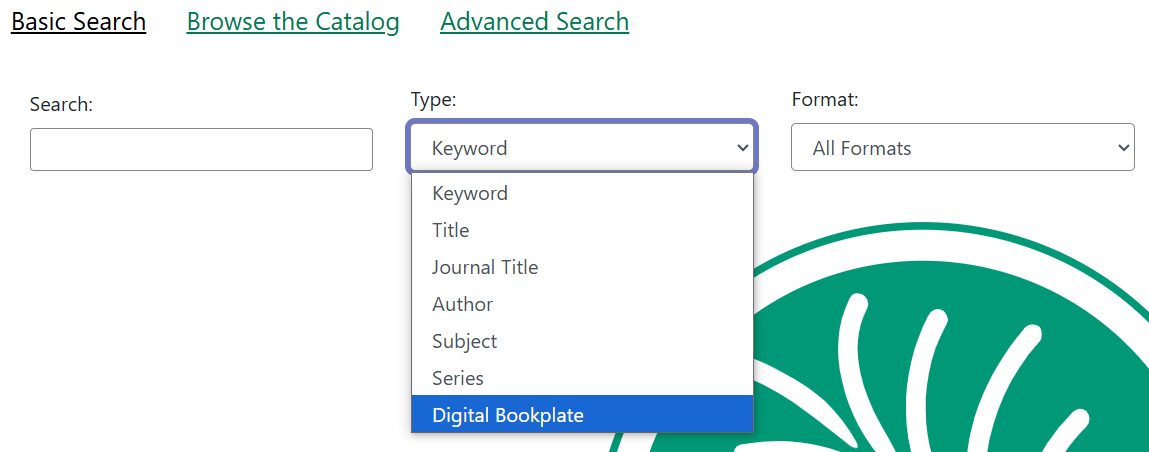
Advanced Search
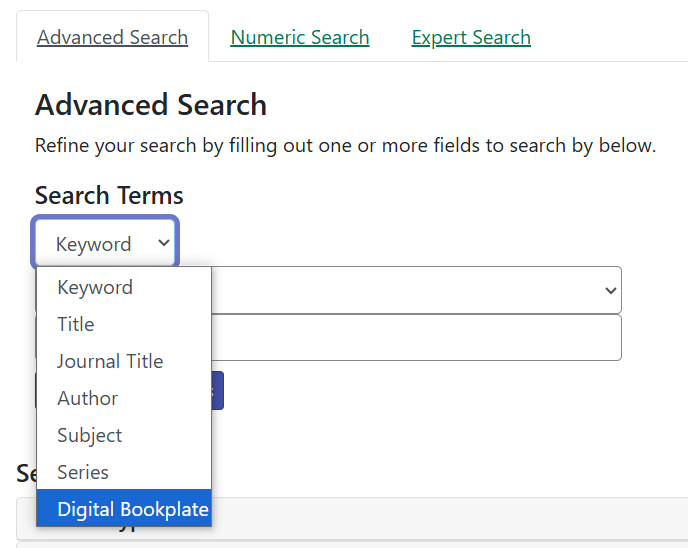
Keyword Search
Item Tags can also be searched by using a Keyword search in the Basic and Advanced search interfaces. Searches need to be constructed using the following syntax:
copy_tag(item tag type code, search term)
For example:
copy_tag(bookplate, friends of the library)
It is also possible to conduct a wildcard search across all item tag types:
copy_tag(*, smith)
If you do not see this option, please submit a help ticket or email NC Cardinal at help@nccardinalsupport.org so that this option can be turned on for you.
Adding Existing Item Tags to Items
Item Tags can be added to existing items or to new items as they are cataloged. To add an item tag:
-
In the Holdings Editor, select Edit Item Tags. This will open a modal named Managing tags for item.
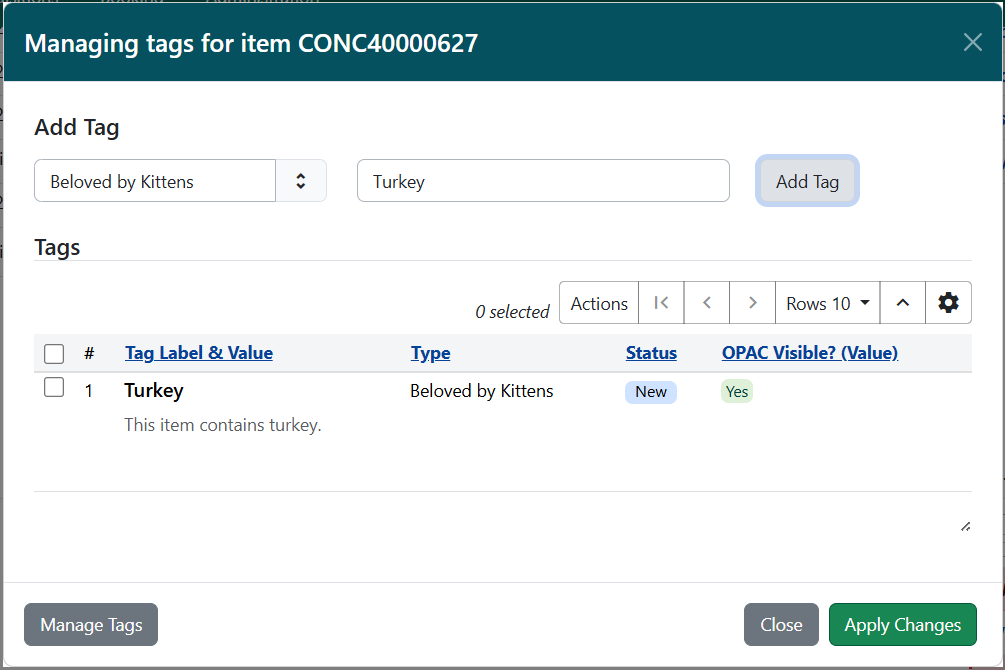
-
Select the Tag Type from the drop down menu and start typing in the Tag field to bring up tag suggestions from the existing item tags. Select the tag and click Add Tag.
-
Your tag will display in the Tags grid below. Columns in this grid include:
-
Tag Label and Value - this shows the tag’s label and its text value.
-
Type - this shows the tag’s type
-
Status - this shows if a tag is newly added. If it is blank, the tag already existed on this item.
-
OPAC Visible - this shows whether or not the tag is visible in the public catalog (OPAC)
-
Additional columns are available in this grid and can be accessed by clicking the gear icon in the top-right of the grid.
-
-
Repeat this as needed for other tags.
-
-
If you need to edit or remove a tag that you have added, hover on the tag row to show actions for Edit Tag (which will open the tags administrative interface in a new tab) and Remove Tag. + TIP: If you need to perform administrative actions on tags, the Manage Tags button will also open the tags administrative interface in a new tab.
-
Once you have added your tags and done any other tag work, select Apply Changes. The modal will close.
-
To close without saving, select Close.
-
-
Proceed with the rest of your edits to the item, and then select either Apply All & Save or Apply All, Save & Exit to finish your edits.
Creating and Applying a Item Tag During Cataloging
Item tags can be created in the Holdings Editor on the fly while cataloging or viewing an item:
-
In the Holdings Editor, select Edit Item Tags. This will open a modal named Managing tags for Items.
-
Select the Tag Type from the drop down menu and start typing in the Tag field to create your new tag.
-
Select Add Tag, and then Create New Tag.
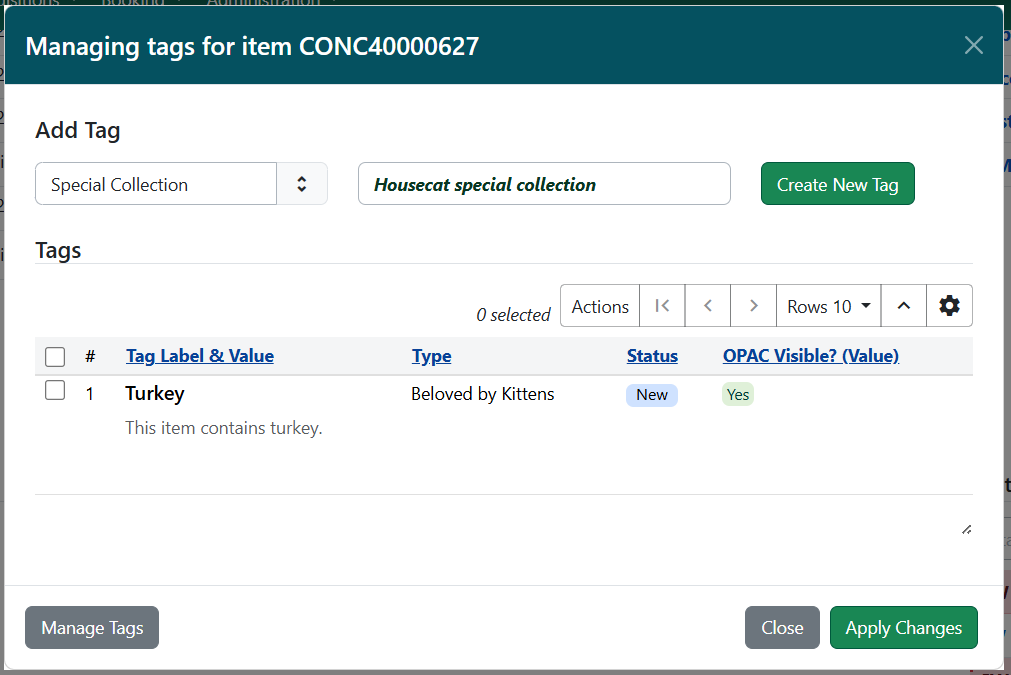
-
Your tag will be displayed in the grid below, and will be saved for future use. The tag will be owned at the Organizational Unit of your workstation.
-
Once you have added your tags and done any other tag work, select Apply Changes. The modal will close.
-
To close without saving, select Close.
-
-
Proceed with the rest of your edits to the item, and then select either Apply All & Save or Apply All, Save & Exit to finish your edits.
Removing Item Tags from Items
To remove an item tag from a item:
-
In the Holdings Editor, select Edit Item Tags. This will open a modal named Managing tags for Items.
-
Hover on the tag row to show the Remove Tag option.

-
Once you have removed your tags and done any other tag work, select Apply Changes. The modal will close.
-
To close without saving, select Close.
-
-
Proceed with the rest of your edits to the item, and then select either Apply All & Save or Apply All, Save & Exit to finish your edits.
Item Alerts
The Item Alerts feature allows library staff to add customized alert messages to items. The item alerts will appear when a specific event takes place, such as when the item is checked in, checked out, or renewed.
Alerts can be temporary or persistent:
-
Temporary alerts will be disabled after the initial alert and acknowledgement from staff.
-
Persistent alerts will display each time the alert event takes place.
Item Alerts can be configured to display at the circulating or owning library only or, alternatively, when the library at which the alert event takes place is not the circulating or owning library. Item Alerts at check in can also be configured to provide options for the next item status that should be applied to an item. Library administrators have the ability to create and customize Item Alert Types and to suppress item alerts at specific org units. See the Item Alerts Administration documentation for more information.
Adding an Item Alert
Item Alerts can be added to new items or existing items using the Holdings Editor. They can also be added directly to items through the Check In, Check Out, Renew, Capture Holds, and Item Status screens; or from the bibliographic record in the Holdings View tab.
To add an Item Alert in the Holdings Editor:
-
At whichever entry point, select your item and then select Actions → Edit Items.
-
If you are in the Holdings View tab, you can also select Actions → Add / Manage Item Alerts. This will open the alerts modal, and you can proceed to step 3.
-
-
Within the Holdings Editor, scroll to the bottom of the screen and select Edit Item Alerts.
-
This will open a modal labeled “Managing alerts for item <barcode>”.
-
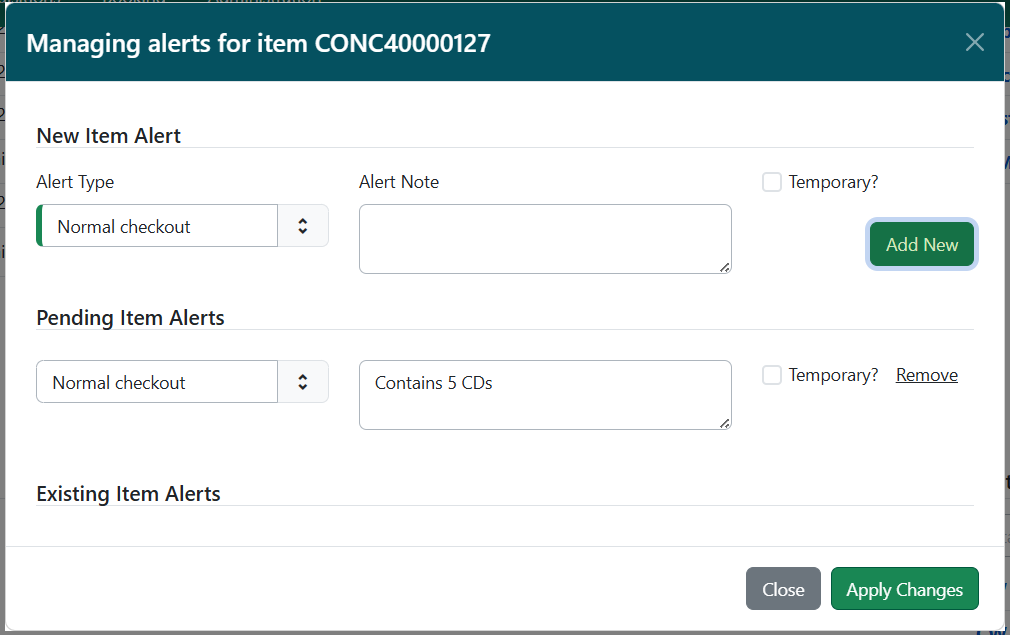
-
Select an Alert Type and enter an additional alert message if needed in the Alert Note field.
-
Select the box next to Temporary? if this alert should not appear after the initial alert is acknowledged.
-
Leaving the Temporary? box unchecked will create a persistent alert that will appear each time the action to trigger the alert occurs, such as check in or check out.
-
-
Select Apply Changes to save the new Item Alert.
-
If you accessed the modal directly from the Holdings View tab, Item Status, or Check In / Check Out interfaces, this will save your changes.
-
To close without saving, select Close.
-
-
After an Item Alert has been added, selecting the Edit Item Alerts button in the Holdings Editor will allow you to add another item alert and to view and/or edit existing item alerts.
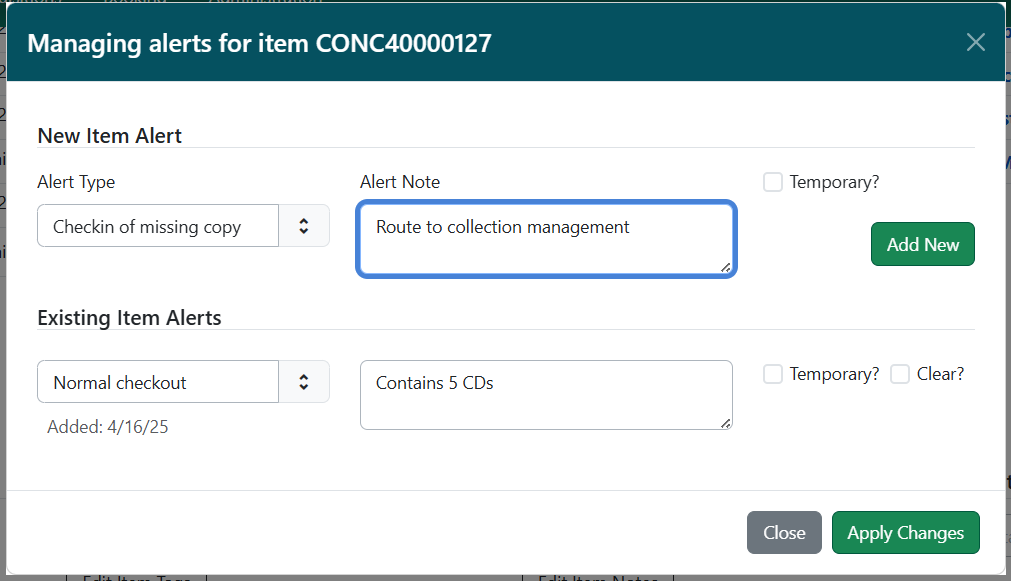
-
Proceed with the rest of your edits to the item, and then select either Apply All & Save or Apply All, Save & Exit to finish your edits.
To add a Item Alert from the Check In, Check Out, Capture Holds, or Renewal screens:
-
Navigate to the appropriate screen, for example to Circulation →Check In.
-
Scan in the item barcode.
-
Select the item row and go to Actions → Add Item Alerts or right click on the item row and select Add Item Alerts.
-
This will open a new tab with a modal labeled “Managing alerts for item <barcode>”.

-
Follow the instructions above, starting with step 4.
-
After an Item Alert has been added, selecting the Manage Item Alerts action will allow you to add another item alert and to view and/or edit existing item alerts.

To add a Item Alert from the Item Status list view:
-
From the Item Status list view, scan in the item barcode.
-
Select the item row and go to Actions → Add Item Alerts or right click on the item row and select Add Item Alerts.
-
This will open a new tab with a modal labeled “Managing alerts for item <barcode>”.

-
Follow the instructions above, starting on step 4.
-
After an Item Alert has been added, selecting the Manage Item Alerts action will allow you to add another item alert and to view and/or edit existing item alerts.

Alternatively, you can add or manage alerts from the detail view in Item Status.
-
Select the Detail View button in the top-right of the Item Status screen.
-
In the bottom-left corner of this view are two buttons for Add and Manage Alerts.
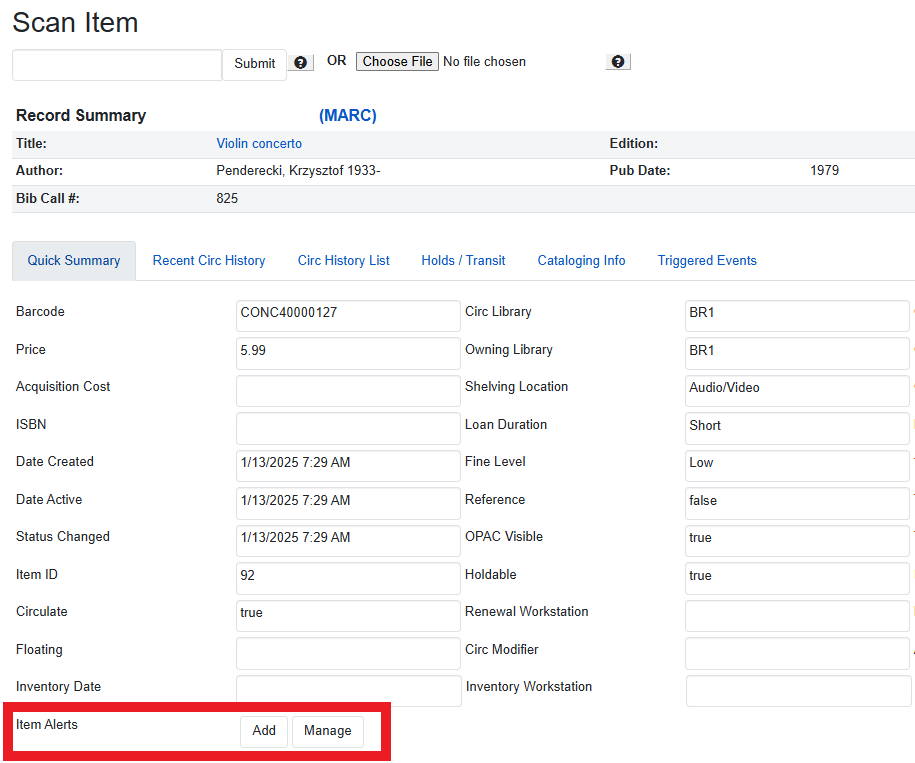
-
Select Add Item Alerts.
-
This will open a new tab with a modal labeled “Managing alerts for item <barcode>”.

-
Follow the instructions above, starting on step 4.
-
After an Item Alert has been added, selecting the Manage button will allow you to add another item alert and to view and/or edit existing item alerts.

Removing an Item Alert
Navigate to the Manage Item Alerts modal via one of the routes described above. Under Existing Item Alerts, select the checkbox next to Clear? for the alert(s) you want to remove. Select Apply Changes to save your changes; or select Close to close without saving.

Adding and Managing Item Alerts in Batch
Item alerts can be added to multiple items in batch via the Holdings Editor, directly from the Holdings View tab, from the Item Status interface, or from circulation interfaces such as Check In, Check Out, Capture Holds, and Renew.
To add item alerts in batch via the Holdings Editor, open a set of items in the Holdings Editor. You can do this from the Item Status interface or from the bibliographic record in the Holdings View tab.
-
At whichever entry point, select your set of items and then click Actions → Edit Items.
-
If you are in the Holdings View tab, you can also select Actions → Add / Manage Item Notes. This will open the tags modal, and you can proceed to step 3.
-
If you are in a circulation interface, or Item Status list view, you can select Actions → Add Item Alerts or Actions → Manage Item Alerts. This will open the tags modal in a new tab, and you can proceed to step 3.
-
-
In the Holdings Editor, select Edit Item Alerts. This will open a modal named Managing alerts in common for <number> item(s).
IMPORTANT: This modal will only show existing alert types that are commonly held among all selected items. Items do note share alerts directly.
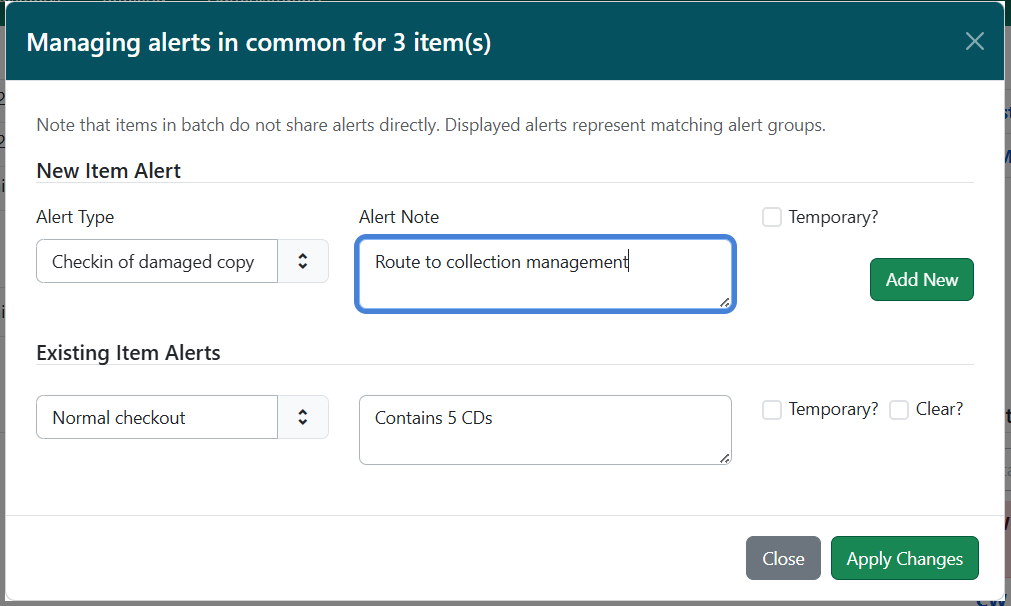
-
Select an Alert Type and enter an additional alert message if needed in the Alert Note field.
-
Select the box next to Temporary? if this alert should not appear after the initial alert is acknowledged.
-
Leaving the Temporary? box unchecked will create a persistent alert that will appear each time the action to trigger the alert occurs, such as check in or check out.
-
-
Select Apply Changes to save the new Item Alert.
-
If you accessed the modal directly from the holdings view tab, Item Status, or check in / check out interfaces, this will save your changes.
-
To close without saving, select Close.
-
-
After an Item Alert has been added, selecting the Item Alerts button in the Holdings Editor will allow you to add another item alert and to view and/or edit existing item alerts.

-
Proceed with the rest of your edits to the item, and then select either Apply All & Save or Apply All, Save & Exit to finish your edits.
-
This page was: Helpful |
Not Helpful